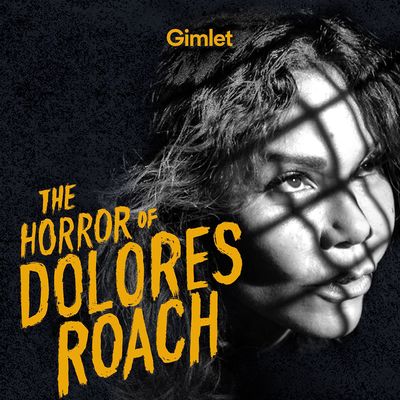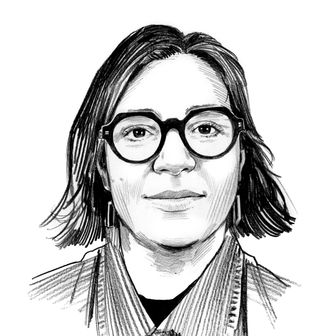
In The Horror of Dolores Roach, Gimlet’s new fiction podcast out just in time for Halloween, Dolores returns home from a 16-year prison stint for pot possession to find her old neighborhood, Washington Heights, unrecognizable. A Chase Bank has replaced the diner, a T-Mobile has taken over the little family-run bakery. “There’s a Planet fuckin’ Fitness,” Dolores says, horrified. The only piece of the old neighborhood that remains is Empanada Loca, run by an old buddy of hers, but business is failing — until Dolores sets up a massage parlor in the basement and has an unfortunate encounter with the sleazy landlord trying to evict them, setting into motion a macabre retelling of Sweeney Todd where cannibalism is a metaphor for gentrification. (It turns out hipsters can’t get enough of the Empanada Loca’s new special ingredient.)
The story began as a one-woman play called Empanada Loca, written by Aaron Mark — a Washington Heights gentrifier, himself — for his muse, Daphne Rubin-Vega, whose breakout role was Mimi in the original Broadway production of Rent, another woman on the wrong end of gentrification’s relentless bite. Unlike Mimi, Dolores isn’t waiting around for a man to save her, a characteristic that Rubin-Vega relishes. “She’s a survivor. A warrior of the people, which I find very thrilling,” Rubin-Vega said over the phone.
In the podcast, Rubin-Vega is joined by Bobby Cannavale, who plays the owner of Empanada Loca, a “misunderstood culinary visionary” (and high-end weed connoisseur) who comes up with a creative solution to dispose of the body after Dolores strangles a customer in a fit of rage, desperation, and euphoria. Rubin-Vega delivers a tour de force performance; as the New York Times put it, in an article about new fiction podcasts, her voice “slinks into the listener’s mind in a way that feels unrivaled in audio.”
The day before Halloween, Vulture caught up with Marks and Rubin-Vega to discuss the inspiration for the podcast, why female serial killers are inherently feminist, and the politics of cannibalism. Beware of spoilers!
How’s it going?
Daphne Rubin-Vega: We are giddy with delight.
So what’s the origin story for this story?
Aaron Mark: I’d been working on a series of one-person horror plays that were contemporary reinventions of old horror characters and properties, and I had this crazy idea for a contemporary reimagination of the old Sweeney Todd legend back from the penny-dreadful days. I wanted to write it for Daphne. I was a huge fan, and she was someone who I’d wanted to work with for a long time. As an audience member, I wanted to see her play a kind of role that I hadn’t seen her play before. So I wrote it for her and sent her the script.
DRV: At the time, I was working on my own solo material, and I wasn’t actually all that interested in his writing. [Laughs.] But when he presented Empanada Loca to me I was blown away. I put down what I was doing. There was an aspect of Dolores, as a survivor, as a spokesperson for every disenfranchised person, that for me personally is a very important story to tell — from my experience as an actor, and more so from my experience as a human being.
She’s a really interesting character, one who I feel like I haven’t met in the horror cannon. A woman of color who has been unjustly oppressed by the criminal-justice system, but who also turns out to be a serial killer. Which feels like a progressive statement of some kind. She’s a female serial killer, and yet her anger is righteous and justified, and yet she also loves murdering people. How did she come together as a character?
AM: That was really the hook from the beginning: Can we meet a character who is behaving in ways that we, hopefully, think we never would behave, and yet we absolutely identify with her and love her? I wanted to do a deep dive into a character we haven’t seen depicted much in the horror cannon. Yeah, she is killing people — and you will identity with her.
DRV: I keep coming back to cannibalism of our culture. It’s not even figurative anymore. We can literally say that we’re a cannibalistic culture. It’s not a condition of this culture, it’s actually a birth defect. What thrills me about Dolores is that she gets to exemplify that in this very dramatic way.
Do you think there’s something inherently feminist and progressive about the idea of a female serial killer?
DRV: Well, yeah. I’m not advocating violence. Not to get it twisted, but to advocate for a strong self-sustaining woman who has embraced the idea that she’s going to unequivocally win at the expense of others if need be — that’s feminist. The embodiment of a female serial killer that we all love is sort of the most outrageous thing we can imagine. I don’t think we sat down and planned it that way, but that’s who she turned out to be.
Why did you decide to set it the story in Washington Heights?
AM: I’ve lived in that part of Washington Heights for nine years now. I moved in at the beginning of what is currently this wave of gentrification that’s happening now at the speed of light. The early part of this was me showing up there and having to grapple with, frankly, myself as a gentrifier. What am I doing here? The character and the story was very much drawn from my experience moving there and watching the gentrification happen. And living on the first floor, where I could hear people all night out my window talking. Dolores is very much drawn from people I’ve known in my neighborhood.
So how’d you get into Dolores’s head?
DRV: Dolores is practical, lovable, goodhearted. She means well. The problem is, the events in her life have been so unfortunate that they’ve led her to make some other unfortunate decisions. But really, she tries to stay good. And I think that’s important. There’s also an element of incredible vulnerability and honesty. Or at least, in the realm of what we’re doing, she’s very honest to us. We can trust her, and I think that’s what makes her work.
Yeah, she reflects on her murders in a really authentic and weirdly endearing way, which makes her very different from, say, Walter White, who’s always justifying everything he does. She’s honest about the euphoria.
DRV: That’s her way of celebrating her power. It’s the only power she gets.
AM: She’s been backed up into a corner to such a degree. For me, as a writer, it was exciting and challenging to embrace, on the one hand, the horror, and on the other, the really fundamental, very frightening, animalistic survival instinct that I think all human beings have. And really, what are the circumstances, for any human being on the planet, that would lead any of us to behave in this way?
DRV: Plus, Dolores is living underground when she’s telling her story. If you’re a sentient being, you might notice that there are people around right now that are having completely different experiences than you are. In the past couple of years, I’ve been living on a block in Chelsea, and on my block, there’s a three-dollar pizza, and there’s a homeless shelter, and a design studio, and one of those waiting-three-months-to-get-into-the-restaurant situations — but people have to walk over homeless motherfuckers to get to that place. That’s a fact. Dolores, whether we like it or not, is a very palpable reminder of the fact that some people are really going underground. And some people don’t come back up. They really don’t. We did a fair amount of research on that.
What kind of research did you guys do for the show?
AM: I did a lot of reading.
DRV: I did a lot of killing. I’m joking!
So what was the collaboration like?
AM: I’d write the scripts, then I’d come and sit in Daphne’s apartment, where we are now, and I’d read them to her out loud, which was a bizarre and weird experience, of reading Dolores for Daphne. And then she’d weigh in.
DRV: I’d go over the script, making it terser, leaner, to make every section pack a punch. Dolores needs to keep the audience there. You’re her victim, but you don’t know that yet. So there’s an urgency there.
I want to talk about the cannibalism. One of the most disturbing parts of the show, I thought, was the way that this new meat source becomes wildly popular and Empanada Loca becomes a successful business again. Why do you think hipsters love human meat so much?
AM: Well, as Louis says — spoiler alert — meat is meat! Flesh is flesh. I mean, I’m not a cannibal myself. But if we’re seeing through the lens of a character who’s really meant to embody this kind of base, animalistic survival instinct that she’s backed into, then it felt right that she would fit into this idea of cannibalism, both literal and figurative. We’re all the same molecules in meat form, walking around.
DRV: The only reason we eat what we eat is because we won. We get to eat animals because we won.
AM: It’s so tied to power dynamics.
DRV: Human flesh is a game-changer, right? It allows Louis to exercise his creative potential. He gets to act out and express his artistic vision, at the expense of life, right? I keep thinking about this image of biting the hand that feeds you — you have to bite the hand that feeds you if you want to make any kind of impression. It only works one way with power.
I’m curious, Daphne. Your breakout role in Rent was also about gentrification. Does this role feel like coming full circle in a way?
DRV: I have this uncanny way of coming full circle in that way. All my roles are interconnected in the sense that I’ve always played someone who is a fish out of water in some way. I represent the other in your neighborhood. It’s funny because, it started out as a joke, but I didn’t even realize how funny– slash–not funny it was. I used to be in a girl group, we made records on Atlantic Records, and we used to be described as the hot blonde, the brunette girl next door, and the ubiquitous urban street element. I was the urban element. The world out there always depicts me as other.
It’s really hard to answer that because, in a way, it’s sort of like asking for approval from a system that doesn’t behoove me to get an approval from. And that’s the thing about Dolores. She doesn’t need your approval.
So what’s next for Dolores? Is she going to come back to the surface? AM: It’s never clear to me what I’m allowed to say and not say, but what I can tell you is that there’s certainly more story for Dolores, and we certainly hope that we’re going to be able to tell the rest of her story.
Did working on the show ruin empanadas for you? Can you eat them now?
AM: After I wrote the play, I couldn’t touch them for about a year. I had a visceral, holy shit, I just killed off one of my favorite foods. I’ve since gotten over that and I eat them all the time.
DRV: When we first got into it, I was so into the idea of making my own empanadas. I made them from scratch, and I overstuffed them, so they were these tails. And I could not bring myself to eat them — they just looked too much like a dead rodent. My son ate them, though. I nibbled at the fried part, but I don’t eat the inside anymore.


